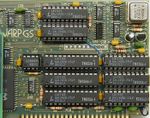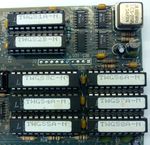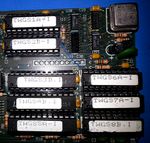TransWarp GS: Difference between revisions
| Line 64: | Line 64: | ||
* 32k Cache Board with 1.8s firmware. | * 32k Cache Board with 1.8s firmware. | ||
* GAL1A, 7ns speed grade (PN: GAL16V8D-7LP) | * GAL1A, 7ns speed grade (PN: GAL16V8D-7LP) | ||
* | * GAL2B, 7ns speed grade (PN: GAL16V8D-7LP) | ||
NOTE: If you experience different speeds or issues that listed here it could suggest your GALs are fakes, defective, or mislabeled. Unscrupulous vendors have been known to "wash" slower GALs and relabel them with faster markings. Many 15ns GALs have been known to have been relabeled and sold as the faster 7ns parts. Unfortunately there is no known "simple" way to test GALs and determine their actual speed rating. Purchasing them from a reputable dealer is your only option to ensure they are in fact original and as marked by the factory. | NOTE: If you experience different speeds or issues that listed here it could suggest your GALs are fakes, defective, or mislabeled. Unscrupulous vendors have been known to "wash" slower GALs and relabel them with faster markings. Many 15ns GALs have been known to have been relabeled and sold as the faster 7ns parts. Unfortunately there is no known "simple" way to test GALs and determine their actual speed rating. Purchasing them from a reputable dealer is your only option to ensure they are in fact original and as marked by the factory. | ||
Revision as of 18:17, 1 September 2017
The TransWarp GS (TWGS) is one of the best and most expandable of the accelerator cards for the Apple IIgs. With its expandable cache and upgradable clock, this card is definitely a must have for every Apple IIgs user. Originally released as a 7 MHz accelerator it is now possible to modify some boards up to 18 MHz.
History
AE released the TransWarp GS in winter of 1988. The board came stock at 7MHz and 8k cache. They later upgraded the board to 8MHz and offered a 32k cache board. The limiting factor to speed at the time was the "buggy" 816 CPU die. Later Western Design Center (WDC) worked with Sanyo to redesign the die, and the CPU speeds easily reached 10MHz. By this time however AE was out of business.
About mid 1996 Joachim Lange (SHH Systeme), a hobbyest, created a new version of the 32k Cache Card for the TransWarp GS. Together with the redesigned 816 CPU some TransWarp GS users were able to reach 12MHz or better.
On January 27th, 2006 Henry from ReActiveMicro announced on CSA2 the successful cracking and copying of the TranWarp GS GALs, and their release for sale and download. Henry discovered that using the redesigned 816 CPU, SHH Systeme's 32k Cache Card, and the last known revision of the GALs that his TransWarp GS reached 18.75MHz and was stable running most software.
In March 2007 ReActiveMicro created a 32k Cache Card which used 12ns SRAMs and allowed for more stable operation above 16MHz.
Upgrading And Overclocking
All TransWarp GS boards can be upgraded to 32k cache. And most TransWarp GS boards can be overclocked to 12-14MHz with little more than a new CPU and oscillator. Some TransWarp GS can be overclocked to 16MHz with only an oscillator upgrade. From 16MHz and on a fan for active cooling is recommended for the GALs.
TransWarp GS speed depends on the oscillator installed. The total TransWarp GS speed, and thus the speed of the IIgs, is the speed of the installed oscillator divided by four. So a TransWarp GS with a 40MHz oscillator installed would allow the IIgs to operate at 10MHz.
AE's 32k Cache Card is good till about 16MHz with 25ns speed SRAM or faster installed and 1.8s firmware. It does not work well for speeds above that. SHH Systeme's 32k Cache Card seems to be good for higher speeds, however SRAM performance starts to become a limiting factor. ReActiveMicro's 32k Cache Card uses 12ns SRAMs and is stable above 16MHz. Other hobbyists have created their own 32k Cache Cards with some faster SRAMs however top TransWarp GS was not affected.
There are some "mods" to the TransWarp GS boards which were installed by AE on their later boards. These do not seem to affect top speed.
See section below for GAL Upgrades and related information.
What Are GALs
The Generic Array Logic (also known as GAL) device was an innovation of the PAL (Programmable Array Logic) and was invented by Lattice Semiconductor. The GAL was an improvement on the PAL, which itself was an improvement on standard Gate Locig ICs like the 74-series. A GAL can emulate many PALs and 74-series ICs in one device, saving cost, power, and PCB real estate. Its primary benefit, however, was that it was eraseable and re-programmable, making prototyping and design changes easier for engineers. AE used a set of 8 GALs on the TransWarp GS.
AE's GAL Markings
AE sometimes used the part number suffix "N" and other times they used "I". "N" labeled parts have a "-" separating them, whereas the early "I" labeled parts have a "-" for separation and later used ".". It is not clear why the differences in suffixes. However there does not seem to be a difference in the way the GALs are programed. This separation and suffix change was product wide and not limited to the TransWarp GS. The differences could have been from when Don Pote sold AE to a new owner in the early 1990's.
The earliest GALs have a "-I" suffix, and all "labels" are silk screen printed to the GALs. It appears most TransWarp GS boards AE date coded from early 1989 have GAL date codes from 1988 and/or 1989. The earliest production boards would have an "A" revision for GAL3. GAL3 revision "B" is a lot more common for early boards, and usually the GALs all have a 1989 date code on them. However in early 1990 AE changed how they labeled their GALs and the "-N" marking made an appearance on a mylar type label. In mid 1990 there are examples of ".I" suffix appearing, and also AE relabeling old GALs or ever over labeling GALs. See the last pic on the right before for these two examples.
GALs were also user upgradeable and therefore some users were know to have replaced them in order to address early CPU bugs or issues between the different IIgs ROM versions. This could explain some of the mix of different labels found.
-
Early Revision "A" GALs, Mostly 1988 Date Codes
-
More Typical GAL Assortment From Early TWGS
-
Early 1990 Datecode TWGS Board GAL Assortment With "-N" Labels
-
Mid 1990 Datecode TWGS Board GAL Assortment With Mix Of Labels
GAL Versions And Speed Grades
GALs 1-2, 6-8 are "GAL16V8" or "GAL16V8A". GALs 3-5 are "GAL20V8" or "GAL20V8A". Lattice Semiconductor found flaws in the GALs security and in early 1989 started to address these issues with the "A" redesign. This is not to be confused with AE's programming revision lettering.
GAL 1 and 2 were always 15ns speed grade. These two GAL connect directly to the oscillator and need to be as fast as possible. The 15ns speed grade is only good to Mhz. 7ns speed grade seem to be good to 18+MHz.
GAL 3 to 5 were always 25ns speed grade.
GAL 6 to 8 were usually 25ns speed grade, but were sometimes the faster 15ns speed grade on later dated TransWarp GS boards.
Why Different GAL Versions
Mostly we do not know for sure what the different GAL revisions do beside allow for a reduction in overall ICs used while allowing for simple redesign of the board's function or connections. They also seem to be used for addressing bug fixes.
The only known GAL is 2 revision "B", and this was a DMA fix Applied Engineering issued. It is an absolute requirement for the TranWarp GS to work at all with at least some RamFAST SCSI boards (e.g. the revision "C" boards). RamFAST revision "D" does not require the 2B GAL.
GAL 3 is know simply by experiment and observation. It is believed this GAL was to deal with the bugs in the original 65815 CPU die. Revision "E" addresses the newer 65816 CPU die redesign and is required for correct operation with the new WDC CPUs and v1.8s of the firmware on the 32k Cache Card. Older CPUs will NOT work correctly with revision "E". The revisions "E" GAL does not work correctly with the old CPUs. Revision "E" is required for above 10MHz operation.
No original GAL source code has been found to date. Without documented source we will never know the reasons for the revisions.
GAL Upgrades
For 16MHz and above the following is required for correct IIgs operation.
- 32k Cache Board with 1.8s firmware.
- GAL1A, 7ns speed grade (PN: GAL16V8D-7LP)
- GAL2B, 7ns speed grade (PN: GAL16V8D-7LP)
NOTE: If you experience different speeds or issues that listed here it could suggest your GALs are fakes, defective, or mislabeled. Unscrupulous vendors have been known to "wash" slower GALs and relabel them with faster markings. Many 15ns GALs have been known to have been relabeled and sold as the faster 7ns parts. Unfortunately there is no known "simple" way to test GALs and determine their actual speed rating. Purchasing them from a reputable dealer is your only option to ensure they are in fact original and as marked by the factory.



